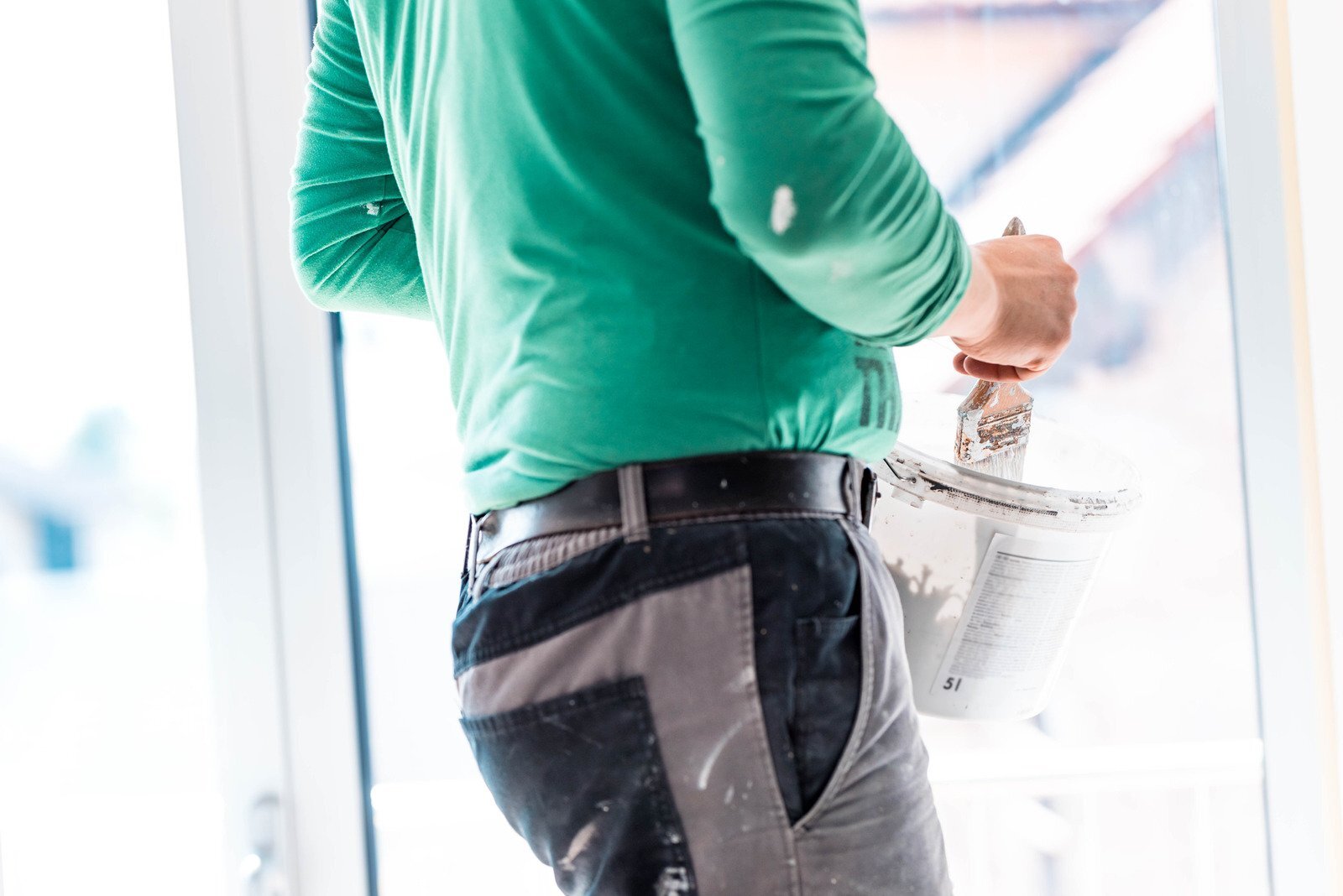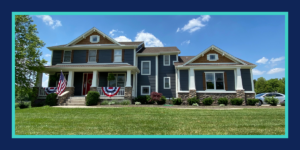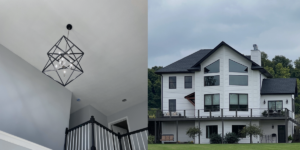There are different reasons why you’d want to paint your unfinished basement walls instead of installing drywall. Leaving the pipes exposed in your basement makes plumbing projects easy to manage as they’re easily accessible.
Painting your unfinished basement also exaggerates the ceiling height to make it appear higher and brightens the space. The painting process might seem challenging, but our experts do all the work to ensure that painting your unfinished basement is manageable. Here are all the details.
Why Paint Your Unfinished Basement?
Painting an unfinished basement is a cost-effective solution to installing drywall. That also saves you time as painting your unfinished basement ceiling, walls, and floors will take less time and you don’t need lots of building supplies.
Painting exposed beams in your basement also gives the entire space a more finished look and feel without heavy renovations. Additionally, all your utilities are easily accessible in case you need any repairs in the future.
How to paint an exposed basement ceiling, floor, and walls
The process of painting an exposed basement ceiling, floors, and walls is only part of your remodeling project. You’ll need to know how to prepare the space for painting and the color to choose. You might also find yourself wondering about the best paint type to use. Fortunately, the professionals at Ohio Painting have done all the work to give you answers to all these questions.
Here’s a step-by-step guide to painting unfinished basement floor joists and ceilings like a pro.
1. Gathering your painting supplies
Planning for your project and gathering the painting supplies is the first step to painting your unfinished basement. Proper planning saves you time in the long run as you’ll have everything you need to handle the project. These supplies include:
Paint:
Oil-based paints are the best option when working with a paint sprayer, but you’ll need paint thinner for the cleanup process. You can also use latex paint, but you’ll need to thin it with water to avoid clogging your paint sprayer.
Latex-based paints are also easy to clean up using water. However, when painting your concrete floor, you’ll need to mix your paint with epoxy for a scuff-proof surface.
Painters’ tape
The painter’s tape helps clean the edges when applied to the trim or over baseboards. It’s also essential for covering shut-off knobs, electrical outlets, and other places you don’t want to paint over.
While using the painter’s taper might seem cumbersome, the results will be worth the effort. The tape helps you to avoid accidents and makes the cleanup process easy.
Primer
Before painting your basement ceiling and walls, primer should be your first coat, especially when using light-colored paint like cream-yellow or white. Our professional painters recommend using two or three primer coats before the paint, especially on exposed pipes. That will save you time, money, and energy as you’ll not need to apply multiple paint coats.
Paint spray gun
Spraying an unfinished basement is easier than using a paint roller. A paint spray gun is highly recommended for efficiency, but you need to ensure the sprayer hose can reach every part of your basement. However, you can use a paintbrush or a roller if the paint sprayer isn’t available.
Flooring protection
Lay a tarp or drop cloth on your floor to make it easy to clean spills and splatters. If you’re painting your basement ceiling or walls, depending on the furniture in the room, you’ll need to cover them with a drop cloth to avoid paint overspray. However, you’ll need to remove the furniture when painting the basement floor.
Personal protective safety equipment
When spraying paint on your basement, you’ll need to wear a respirator when working, especially when your room lacks proper ventilation. You’ll also need safety glasses, coveralls, or a paint suit to avoid ruining your clothes. Hair covering is also essential, especially when spraying paint over the ceiling.
Spray Insulation
This insulation helps you cover all the gaps in your surface for a smooth surface.
2. Cleaning the painting surface
Before applying the painter’s tape or laying down the drop cloth, thoroughly clean your basement. You’ll also need to remove any ceiling insulation using a broom or brush and wipe down the basement rafters, ducts, and pipes from all the nooks.
You’ll also want to vacuum up any dust or dirt using a vacuum cleaner before scrubbing the floor with detergent on the area you want to paint. Remember that spray paint requires perfect prep for the best results.
3. Ensuring proper conditions
Every area you plan to paint needs certain conditions for optimal results. Start by testing your basement’s humidity by applying tape to a clean concrete surface. If there’s moisture on the tape after 24 hours, get a dehumidifier to regulate the temperature and get positive outcomes. Your basement’s temperature should range between 40 and 90 degrees Fahrenheit.
4. Paint your unfinished basement
Applying the primer
Now that all your equipment is ready and you’ve ensured the right conditions are present in your basement, you’re ready to start painting. However, depending on the paint color you’re using, you’ll need a layer or two of primer.
We recommend using a shellac primer to avoid yellowing on joints if you’ve chosen white paint. You’ll also need a primer when painting over colored PVC pipes and exposed ceilings. However, you might need to fill any gaps or cracks on the surface using foam insulation before applying the primer for a smooth surface.
Spray painting
After giving the primer enough time to dry, be ready to start spraying the paint. If your basement ceiling, walls, and other surfaces are well primed, you’ll only need to apply a coat or two of your actual paint.
Spraying your basement is the most efficient way to apply the paint and only takes several hours. That includes the drying time between the coats. However, spraying the ceiling requires a paint sprayer with a long-reaching hose.
How to prepare your unfinished basement for painting?
Removing furniture from your space is the first step toward preparing your unfinished basement ceiling for painting. As discussed, you also need to clean the whole basement and gather your supplies ahead of time.
Concrete walls are challenging to paint, especially if the paint isn’t well prepared. We recommend adding epoxy to your paint before starting to paint your cement floor to give it that hard, scuff-proof look. However, you’ll need to apply the paint and dry it within a short time, so nothing should be on the floor.
What color should I paint an exposed basement?
The paint color is about personal preference, but we can recommend several colors for an unfinished basement. White ceiling paint brightens your space, giving it a fresh, clean look. However, you’ll have to apply a shellac primer before applying the paint.
Black paint is also recommended for unfinished basements as it will help conceal imperfections like wires and copper pipes. However, it makes your space seem smaller.
Grey is also a popular color in many home decor projects as it offers the brightening effect of a light color like white. It also helps to conceal any unfinished details in your basement.
What’s the best paint type for an unfinished basement?
When painting cement basement floors, epoxy floor paint is the best option. You’ll also need to add a catalyst to your paint to make it harden quickly. That’s why you’ll need to plan to paint your floor promptly.
We recommend using epoxy-fortified acrylic paint for the remaining surfaces of your unfinished basement(walls and ceilings). This paint type is best known for its durability, but you’ll need to give it five days to cure fully. Additionally, it would help if you asked for a flat finish when getting your paint mixed, as any shine draws attention to any flaws.
How can I use my unfinished basement?
An unfinished basement is ideal for different things. You can use the space as a workout room as it’s far from the rest of the house and away from distractions. The space is also excellent for storing food and other supplies.
If you don’t have a usable workspace or garage, an unfinished basement is an excellent workshop for woodworking, painting, and other projects. If you convert your unfinished basement into an art studio, the paint splatter will just add inspiration and charm to your space.
How can I make an unfinished basement warmer?
Unfinished basements will always feel colder than other rooms in your home. That’s because it’s cooler underground than above ground, and basements trap cool air. Unfinished basements also maintain excess moisture, making the air feel cool and damp.
Insulating your unfinished basement is the best way to warm up your space. You also need to replace drafty windows, as they’re often to blame for moisture buildup in most unfinished basements. You’ll also need to seal gaps between your home’s foundation and the basement.
Besides sealing air leaks and eliminating crawl space drafts, you can install extra heating systems or buy space heaters through your ductwork. Some homeowners prefer radiant in-floor heating as it evenly heats their space.
Should I decorate an unfinished basement?
Like any other room in your house, adding decor and accents is the best way to complete your unfinished basement without investing more cash in fully renovating the space. You can consider adding things like area rugs and hanging light fixtures, bringing in details that will add more ambiance, warmth, and texture. You can also add house plants and fun furniture to the space to give it more life.
How can I avoid mold problems when painting an unfinished basement?
If your basement walls are made of drywall, the painting process will be easier than those without. Unfortunately, most basements aren’t built with drywall, making painting more complicated.
When your basement walls are built with concrete, brick, or paneling, painting it will be a complex process. The potential for mold growth is among the most significant risks when painting an exposed basement ceiling or walls.
Naturally, concrete is averse to mold, but it will undoubtedly become a huge problem in high-humidity areas or places prone to flooding. As such, you should avoid painting an exposed basement ceiling and walls in areas with excess water, as mold is the perfect food for mold. Before painting the ceiling and walls, you can also consider adding a waterproof primer.
How much does painting your unfinished basement cost?
The cost of painting your exposed basement ceiling, walls, and floor depends on the square footage, any appliances that need moving, the paint type, and other tools needed. Whether you paint the basement yourself or hire a professional like the Ohio Painting Company will also be a huge determinant of the cost.
Most professional painting contractors in Dayton, Ohio, charge an average of $3–$10 per square foot for basement walls and $1–5 per square foot for exposed basement ceilings. Basement floors cost an average of $3–$15 per square footage with an epoxy finish.
Should I have my basement’s exposed ceiling painted by a professional?
With all the challenges that painting an unfinished basement presents, it’s best to lean towards the professional painters at The Ohio Painting Company. Our painting professionals are excellent communicators, are insured, and all the costs are transparent.
Do you need a professional painter for your unfinished basement in Dayton, Ohio? The Ohio Painting Company is the solution!
While handling your unfinished basement project might save you money, The Ohio Painting Company is the better solution when looking for quality work with minimal mistakes. Call (937) 409-4443 to get your basement project finished faster and more efficiently!






